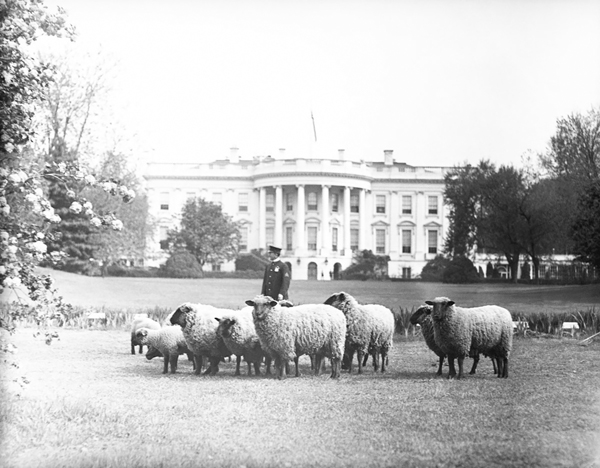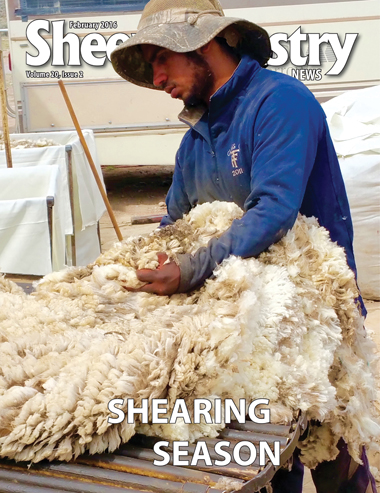KYLE PARTAIN
Sheep Industry News Editor
Thomas Jefferson, James Madison, Woodrow Wilson. Elementary school history classes begin to teach us the names of these former U.S. presidents at an early age. As we celebrate Presidents’ Day this month – surely you’ve got a holiday barbecue planned, right? – February is a good time to take a quick look back.
 Mostly, children learn dates associated with these men. Jefferson was president from 1801 to 1809. Madison followed, serving through 1817. Woodrow Wilson came much later, leading the country from 1913 to 1921 – a period that included World War I.
Mostly, children learn dates associated with these men. Jefferson was president from 1801 to 1809. Madison followed, serving through 1817. Woodrow Wilson came much later, leading the country from 1913 to 1921 – a period that included World War I.
Besides serving two terms as president, the three men had something else in common: sheep. Funny, I don’t recall any mentions of that in my decades of history classes. A few months back, I shared a photo of sheep grazing on the White House lawn. It was from the early 1900s, when Wilson used sheep to handle lawn maintenance during the war. A post on WhiteHouseHistory.org, says an auction of their wool later raised nearly $53,000 for the Red Cross.
But it wasn’t the first time that sheep ran amok at 1600 Pennsylvania Ave. John Adams was the home’s first resident when he moved to the house in 1800, near the end of his second term. Jefferson followed in 1801 and brought at least some of his sheep with him from his Monticello home to Washington, D.C.
A longtime fan of agriculture – which of course nearly everyone was back then – Jefferson’s fascination with sheep breeding was well documented before he was elected president.
Monticello.org carries an in-depth excerpt from Lucia Stanton’s “Sheep for the President,” which appeared in Fall Dinner at Monticello, Nov. 3, 2000, in Memory of Thomas Jefferson.
Pulling from various historical sources, Stanton details Jefferson’s fascination with sheep breeding, including his quest for the elusive Spanish Merino.
“In 1795, the son of a ram smuggled out of Spain by the captain of one of Robert Morris’ ships arrived at Monticello, where he exercised sole dominion over the sheep pastures for seven years and was succeeded by his own offspring. In 1810, Jefferson, therefore, could claim that his flock, which he believed to be Spanish Merino, was ‘as pure as the original.’”
While Jefferson generally refused gifts of value as president, “sheep made it through the gauntlet of his gift policy. He declined sculptures and barrels of wine, but accepted rams and ewes from naval captains, diplomats and civil servants, and even book sellers.”
Eventually, he corrupted Madison, his White House successor, and the two were able to acquire Merino sheep thanks in part to Napoleon’s invasion of Spain.
“William Jarvis, American consul at Lisbon, ‘ever attentive to the interests and welfare of my country,’ bought almost four thousand of ‘the best blooded sheep in Spain.’ Eight of them he designated as gifts for the President and ex-President (Madison and Jefferson),” Stanton wrote.
“The Merinos’ advance reputation and the astronomical prices given for them created expectations that were universally disappointed. Monticello overseer Edmund Bacon, recalled years later that ‘we were greatly disappointed. The sheep were little bits of things, and [Madison’s overseer] said he would not give his riding whip for the whole lot.’ Even Jefferson admitted that ‘they are the smallest things I have ever seen in the form of sheep.’ They also infected the whole Monticello flock with scab. But – at last – the wool of one of his Merino ewes was judged the best ever seen in Washington.”
History buffs will enjoy the entire article, which can be found at Monticello.org/site/plantation-and-slavery/sheep.
Happy Presidents’ Day.



 Mostly, children learn dates associated with these men. Jefferson was president from 1801 to 1809. Madison followed, serving through 1817. Woodrow Wilson came much later, leading the country from 1913 to 1921 – a period that included World War I.
Mostly, children learn dates associated with these men. Jefferson was president from 1801 to 1809. Madison followed, serving through 1817. Woodrow Wilson came much later, leading the country from 1913 to 1921 – a period that included World War I.